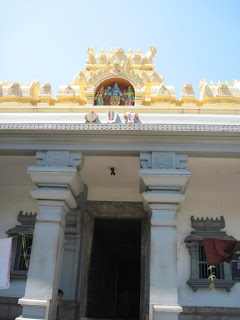Today [7th Dec 2011] is an all important day for Srivaishnavaites– ‘shukla paksha’ dwadasi of the month of Karthigai. [shukla paksham is the waxing phase of Moon and dwadasi is the 12th day – the day following Ekadasi]. Today is “Kaisika Dwadasi”. In Divyadesams, most importantly at Thirukurungudi, Thiruvarangam and in Thiruvallikkeni – ‘kaisika puranam’ is read before the Lord. Today, evening there will be veedhi purappadu of Sri Parthasarathi at Triplicane.
Legend has it that on every Kaisika Ekadasi day, Nampaduvaan, an ardent devotee of the Lord Maha Vishnu used to do Namasankeerthanam for Emperuman at Thirukurungudi. This Nampaduvan Charithram was narrated by Sri Varaha Perumal to Bhoomi Pirarttiyar in Varaha puranam.
The gist of the story is given here :
Nampaduvaan, a great bhagavatha at Thirukurungudi used to observe ‘jakratha vratham’ without sleeping full night singing the glory of the Lord and thinking only about Him. This went on for 10 and more years…..
One year while on the way to the temple 0f Thirukurungudi, perhaps Malai Nambi sannathi, which is situate on hill in dense forestry, Nampaduvan was confronted by a Brahma Rakshas. This Rakshas tells Nampaaduvaan that he would eat him. Nampaduvan humbly requests that he had the duty of nama sankeerthanam. Nampaduvan pleads with the rakshas that he would return back after his vratham and darshan of Kurungudi Nambi. The rakshas naturally was not prepared to believe and states that none in this material would come back as food when death is certain and asks : is there any possibility that a deer could escape after it was caught up by a lion ?
Nampaduvan has nothing else in life but his sincere devotion to Lord Nambi. He promises that he would indeed return; he mentions of the various sins that he would get, if he were not to return. When he says that he has been rendering this for 10 years, the brahmarakshas says that it had been without food for 10 days and is so hungry that it immediately wants to devour the flesh and blood of the devotee. Nampaduvaan finally convinces the rakshas to release him for a while. With intent will, he goes straight to Thirukurungudi temple renders pasurams on Sri Vadivazhagiya Nambi; kaisikam is a kind of music composition (called pan in tamil); the last pasuram rendered was kaisika pan.
Completing his determined wish, he returns as stated back to Brahmarakshas. While returning Nampaduvan is interrupted by Sri Kurungudi Nambi Himself in the disguise of an old man advising him to take alternate route escaping the rakshas. Nampaduvan firmly tells that he will keep his promise, would stand by his dharma and would go back to the rakshas. He even says that if the rakshas is not found in the appointed place, he would further go in search of the rakshas. Such is his commitment that he indeed fulfills his vow and presents himself before the Brahma rakshas.
The Brahma rakshas is startled by the return of Nampaduvaan and offers to free him, if he were to transfer the fruits of his dharma; Nampaduvaan retaliates saying that he had agreed to offer himself and is for the taking. Awe struck the rakshas asked for the palan(fruit) of the pasurams Nampaduvan had rendered and in the series of discussions that went on rakshas wanted atleast the palan of the last kaisika pan.
It gets revealed that the Brahmarakshas was a vidwan by name Soma Sharma who was cursed by Devas arising out of his ahankaram. The palan of pan (the song) relieves him of the curse.
This occurred thousands of years ago and few hundred years ago, on Kaisika Dwadasi day, Sri Parasara Bhattar chanted kaisika puranam before Lord Ranganatha and today the descendants of Bhattar chant the puranam on kaisika dwadasi day at Srirangam.
This morning it was read out in characteristic manner by Sri U.Ve M. A. Venkatakrishnan Swami at Sri Parthasarathi Swami temple. It is stated that the story of Nampaduvaan is in the 48th chapter of Sri Varaha Puranam,; explains and emphasizes the importance of singing the glory of Lord Sriman Narayana. Sri Varaha Purana is considered one of the major eighteen Mahapuranas.
As you would know, Thirukurungudi divyadesam is in Tirunelveli District, nearer Nanguneri – the greatest place for Thennacharya Sri Vaishanavas, better known as Vanamaamalai. Apart from the big temple looking like a Fort, there is another temple atop the hill known as ‘Malai Nambi Kovil’.
The World exists on promises and fulfillment of them and the story of Nam Paduvaan only describes the greatest virtues of those devoted and commited to Lord. They will never err or sin in life.
It is believed that those who go to temple on this holy Kaisika Dwadasi day and read ‘kaisika purana’ will be showered with munificence of Lord ; those who hear ‘kaisika purana’ will also get His choicest blessings and perhaps all of us who read and think of Nampaduvaan and Lord would also be getting the bountiful blessings of Lord Sriman Narayana
Azhwar Emperumanaar Jeeyar Thiruvadigale Saranam
Adiyen Srinivasadhasan.
I had posted on this 2 years earlier, yet writing again [with some additional inputs and for those newly added to my group]
Nambi Rayar Kovil Entrance
Azhagiya Nambi Rayar Gopuram
Panoramic view of Malai Nambi Thirukovil.
Malai Nambi Gopuram














